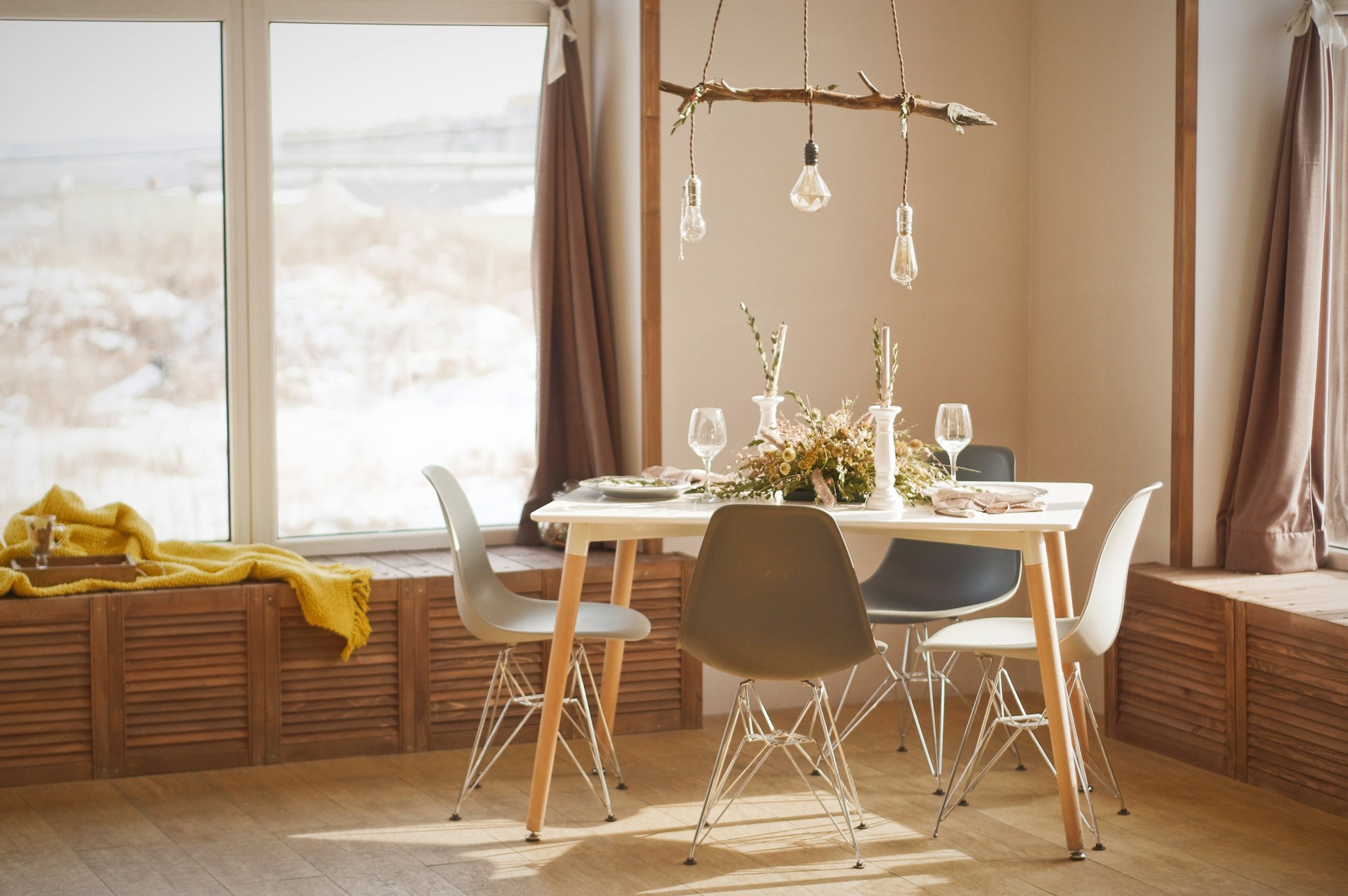We’ve all been there before, that feeling of warmth and invitation that comes with a well designed space. Maybe it was at a hotel, or an Airbnb. Or maybe a close friend just did a revamp. Once you’ve seen it and felt it, you don’t easily forget it. So the big question: What should I focus on when creating warmth in a home?
Embrace The Power Of Color
The colors you choose for your home really does set the stage for its overall feel. While warm hues are key, it’s important to understand how to use them effectively. Terracotta, for instance, can infuse a room with a rustic, earthy feel. It pairs beautifully with natural elements like wooden furniture or greenery. Rich yellows, on the other hand, bring a sunny, cheerful vibe. They work exceptionally well in kitchens or dining areas where you want to evoke a sense of energy and joy.
Soft pinks, while often underrated, can add a touch of sophistication and warmth without overwhelming the space. This pinterest board shows exactly that. They’re perfect for bedrooms or reading nooks, offering a gentle, calming presence. The trick with color is to find the right balance. You might not want a whole room painted in bright yellow, but a yellow accent wall, complemented by neutral tones like greys or whites, can create a balanced yet warm ambiance.
Layer Textures For Depth
Texture is another key element in making a space feel warm and inviting. Remember, it’s all about creating a sensory experience that invites people to touch, relax, and feel at home. Start with the floor – a plush area rug not only adds warmth underfoot but also anchors the room, bringing all the elements together. Natural fiber rugs like jute or wool add an organic feel, while fluffy, soft rugs scream comfort.
On your sofas and chairs, mix and match throw pillows in various fabrics like velvet, linen, or chunky knit for an eclectic, cozy look. Blankets and throws are not just functional for those chilly nights; draped over a couch or chair, they add an inviting layer. It’s all about the feeling you get when you walk into a room. Does it invite you closer? Don’t forget about curtains; thick, heavy curtains can add drama and warmth to a room, while sheer, lighter ones can soften the overall look.
Light It Right
The right lighting can transform a room from cold and uninviting to warm and welcoming. It’s all about the layers of light – a mix of ambient, task, and accent lighting. Ambient lighting, like soft overhead lights, provides the base layer of light in your home, think of it as your foundation lights. Dimmer switches are fantastic for adjusting the light level to match the mood and time of day.
Task lighting is essential in areas where you perform specific tasks, like reading or cooking. A stylish table lamp next to your favorite reading chair or under-cabinet lights in the kitchen can make these activities easier to do, while still looking awesome. Accent lighting, such as wall sconces or picture lights, add a touch of interest. They can be used to highlight architectural features, artwork, or other focal points in your home.
One often-overlooked aspect of lighting is the color temperature of the bulbs. Warm white bulbs, typically around 2700K to 3000K on the color temperature scale, gives a cozy, warm light that’s perfect for living spaces and bedrooms. Cooler whites, on the other hand, are more suited for areas where you need alertness and concentration, like home offices.
Nature’s Touch
Building elements of nature into your living space about way more than aesthetics; it’s about creating a connection to the outside world and bringing a sense of calm and tranquility indoors. Houseplants are a fantastic way to do this. They come in all sorts of shapes, sizes, and colors, allowing for endless creativity in your decor.
For those not blessed with a green thumb, don’t stress about it, it’s easier than it looks. Many plants thrive with minimal care. The snake plant, for instance, is almost indestructible and requires very little water. Similarly, succulents are a great choice as they are both beautiful and low maintenance. Don’t limit yourself to potted plants; hanging plants can add dimension to a room, and small herb gardens in the kitchen are not only practical but also add a fresh, green touch and a vibrant feeling and smell in your home.
Personalize With Memories
What is a home when it evokes no emotion? Your home should be a collection of memories, reflecting your personality and journey. Personal items like family photos, artwork, or collections can transform a house into a home. When displayed thoughtfully, these items tell a story and create a space that’s both unique and deeply personal.
Family photos can be displayed in a gallery wall, mixing frames of different sizes and finishes for an eclectic look. Travel souvenirs, whether it’s artwork, textiles, or knick-knacks, can serve as conversation starters and daily reminders of your adventures. Even books can be more than just reading material; they can be arranged in a way that adds color and interest to a room. The key is to find a balance that avoids clutter while showcasing your personal items in a way that feels intentional and harmonious.
Furniture That Invites Comfort
Now this is a biggie. Because furniture often takes up so much space in a home, the wrong furniture can really break the look and feel you’re after. Choosing the right furniture is super important in creating a warm and inviting home. It’s not just about aesthetics; it’s about comfort and functionality. The furniture should invite you to sit down, relax, and feel at ease.
Remember, furniture arrangement is just as important as the furniture itself. Create intimate seating arrangements that encourage conversation and interaction. Allow enough space between pieces for easy movement, but keep the arrangement cozy enough to promote a sense of closeness and comfort.
Subtle Efficiency
Efficiency in your home doesn’t mean sacrificing comfort or style. Modern, efficient home features can be incorporated in a way that enhances the warmth of your space. Energy efficient sliding doors, for example, are a perfect embodiment of this principle. They not only cut down on energy costs but also bring in an abundance of natural light, making your space feel brighter and more open. Plus, they offer a seamless view of the outdoors, creating a connection with nature while maintaining the cozy atmosphere inside.
Other efficient features like smart thermostats or LED lighting also contribute to a warm, yet environmentally conscious home. These technologies allow for convenience and comfort, ensuring your home maintains the perfect temperature and lighting without excessive energy use.
Engaging The Senses
A truly warm home is one that delights all the senses. It’s not just about what you see, but also what you hear, smell, and feel. Background music can significantly affect the mood of a space. A soft, melodic soundtrack can create a relaxing ambiance, perfect for unwinding after a long day.
Scent is another powerful tool. Candles, essential oil diffusers, or even freshly baked goods can fill your home with inviting aromas that make it feel more lived-in and welcoming.
Cozy Nooks And Corners
Every home needs a personal retreat, a cozy spot where you can escape with a book or a cup of tea. Creating a nook or a corner dedicated to relaxation can greatly enhance the warmth of your home. This could be a window seat adorned with cushions and throws, a small reading corner with a comfortable chair and a bookshelf, or even a cozy alcove with soft lighting and a few cherished items.
These spaces don’t need to be large; it’s about creating an intimate area that feels separate from the busyness of daily life. This personal space should feel like a sanctuary, a place where you can recharge and find peace.
There you have it, nine focus areas to infuse warmth into every part of your home. Remember, creating a warm home is a process, not a destination. Take your time, experiment, and most importantly, make it a reflection of what makes you feel comfortable and happy.


